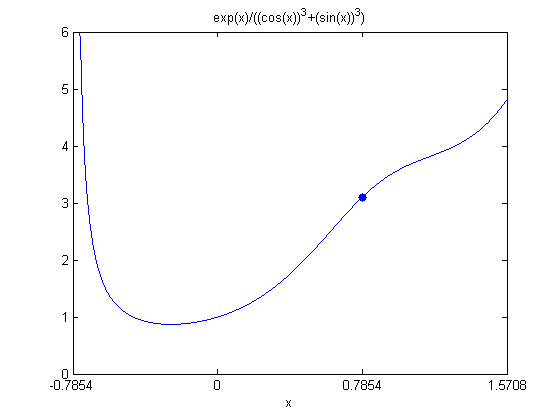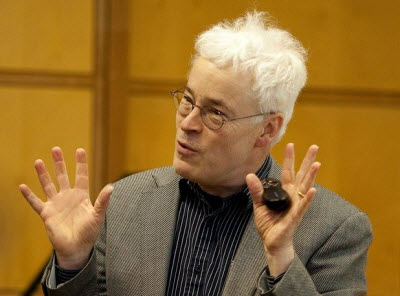CHEBFUN, Numerical Computing With Functions
Contents
Chebfun
For a description of Chebfun we quote the web site,Chebfun is a collection of algorithms and an open-source software system in object-oriented MATLAB which extends familiar powerful methods of numerical computation involving numbers to continuous or piecewise-continuous functions.
Runge's Function
Exercise 3.9 and the programrungeinterpfromNumerical Computing with MATLABinvolves an example due to Carle Runge, $$ f(x) = \frac{1}{1+25x^2} $$ The program demonstrates the fact that interpolation of $f$ by polynomials based on sampling $f(x)$ at equally spaced points does not provide uniformly accurate approximants. Chebfun provides the answer to part 3.9b of the exercise, which asks how the interpolation points should be distributed to generate satisfactory interpolants. The answer, Chebyshev points, also generates the first half of Chebfun's name. Here is a chebfun of Runge's function, plotted with linestyle'.-'to show the Chebyshev points.f = @(x) 1./(1 + 25*x.^2); F = chebfun(f); plot(F,'.-') xlabel('x') title('Runge''s function')
 You can see that the interpolation points are concentrated nearer the ends of the interval, at the zeros of the Chebyshev polynomials, $$ x_j = - \cos {j \frac {\pi}{n}}, \ \ \ j = 0, ..., n $$ Here we need a fair number of points to get a polynomial approximation that is accurate to floating point precision across the entire interval.
You can see that the interpolation points are concentrated nearer the ends of the interval, at the zeros of the Chebyshev polynomials, $$ x_j = - \cos {j \frac {\pi}{n}}, \ \ \ j = 0, ..., n $$ Here we need a fair number of points to get a polynomial approximation that is accurate to floating point precision across the entire interval.n =兰gth(F)-1
n = 182The use of Chebyshev points not only leads to accurate approximations, it also makes it possible to use powerful mathematical tools including Fourier transforms and barycentric coordinates in the underlying operations.
Accuracy
We can assess the accuracy for this example by computing the residual at a large number of randomly chosen points in the interval.x = 2*rand(2^10,1)-1; residual = max(abs(f(x) - F(x)))
residual = 1.8874e-15The computed residual results from three quantities, all of roughly the same size, the actual error $|f(x) - F(x)|$, as well as the floating rounding errors generated in evaluatingf(x)andF (x).
Methods
The querylength(methods('chebfun'))
ans = 203reveals that there are over 200 methods defined for thechebfunobject. There are additional methods defined for some subordinate objects. The overall design objective has been to take familiar MATLAB operations on vectors and generalize them to functions. For examplesum,
I = sum(F)
I = 0.5494computes the definite integral, $$ I = \int_{-1}^{1} {F(x) dx} $$ andcumsum,
G = cumsum(F); plot(G) xlabel('x') title('indefinite integral')
 computes the indefinite integral $$ G(x) = \int_{-1}^{x} {F(s) ds} $$
computes the indefinite integral $$ G(x) = \int_{-1}^{x} {F(s) ds} $$Chebfun Project
Professor Nick Trefethen and his student Zachary Battles began the Chebfun project in 2001 at the Numerical Analysis Group at Oxford. Today there is a second group at the University of Delaware under Professor Toby Driscoll. There have been a number of graduate and postdoctoral students over the years at both institutions. Dr. Nick Hale at Oxford currently manages the project. The MATLABpublishcommand has been used to prepare the first edition of the documentation, as well as prepare the LaTeX source for a hard copy book that will be published shortly. Version 4.2 of the Chebfun software was released in March andis availablefrom the Chebfun web site. The Chebfun team is using an open source software development model.- Category:
- Algorithms














 Cleve’s Corner: Cleve Moler on Mathematics and Computing
Cleve’s Corner: Cleve Moler on Mathematics and Computing The MATLAB Blog
The MATLAB Blog Steve on Image Processing with MATLAB
Steve on Image Processing with MATLAB Guy on Simulink
Guy on Simulink Artificial Intelligence
Artificial Intelligence Developer Zone
Developer Zone Stuart’s MATLAB Videos
Stuart’s MATLAB Videos Behind the Headlines
Behind the Headlines File Exchange Pick of the Week
File Exchange Pick of the Week Hans on IoT
Hans on IoT Student Lounge
Student Lounge MATLAB Community
MATLAB Community MATLAB ユーザーコミュニティー
MATLAB ユーザーコミュニティー Startups, Accelerators, & Entrepreneurs
Startups, Accelerators, & Entrepreneurs Autonomous Systems
Autonomous Systems







Comments
To leave a comment, please clickhereto sign in to your MathWorks Account or create a new one.